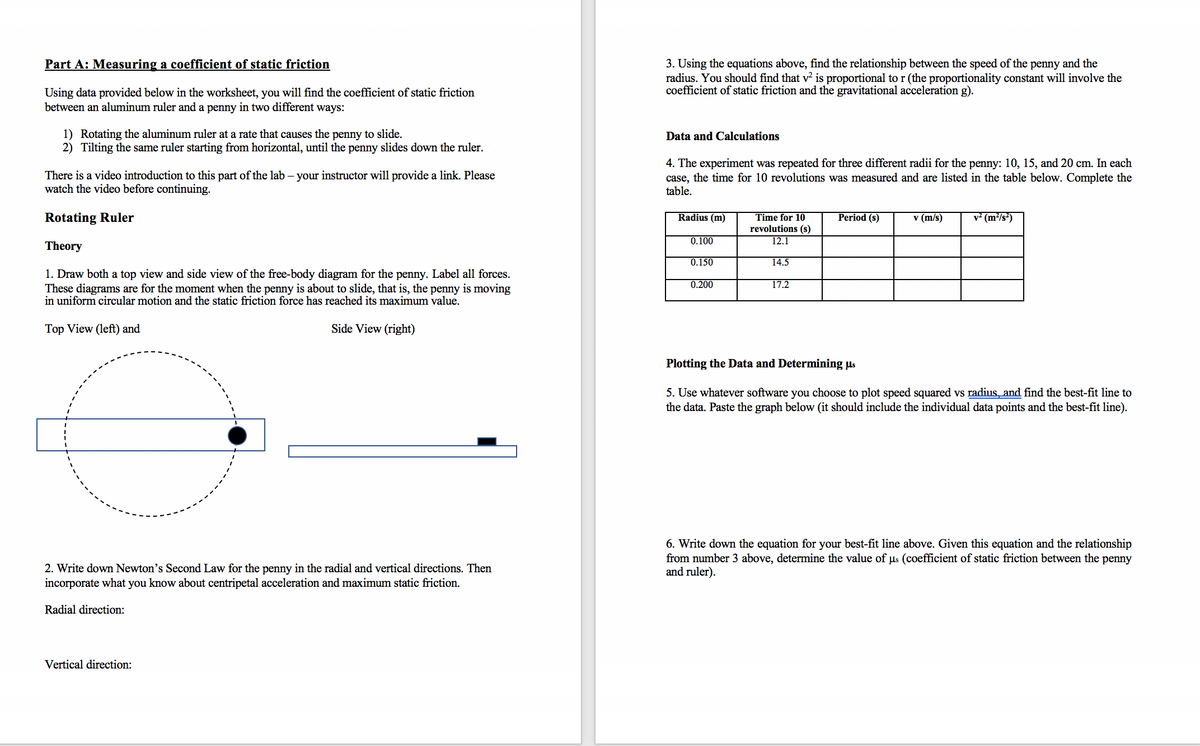4. The experiment was repeated for three different radii for the penny: 10, 15, and 20 cm. In each case, the time for 10 revolutions was measured and are listed in the table below. Complete the table. v (m/) Time for 10 revolutions (s) 12.1 Radius (m) Period (8) 0.100 0.1.50 14.5 0.200 17.2
4. The experiment was repeated for three different radii for the penny: 10, 15, and 20 cm. In each case, the time for 10 revolutions was measured and are listed in the table below. Complete the table. v (m/) Time for 10 revolutions (s) 12.1 Radius (m) Period (8) 0.100 0.1.50 14.5 0.200 17.2
Related questions
Question
Would you help me question 4, 5, 6

Transcribed Image Text:Part A: Measuring a coefficient of static friction
3. Using the equations above, find the relationship between the speed of the penny and the
radius. You should find that v is proportional to r (the proportionality constant will involve the
coefficient of static friction and the gravitational acceleration g).
Using data provided below in the worksheet, you will find the coefficient of static friction
between an aluminum ruler and a penny in two different ways:
1) Rotating the aluminum ruler at a rate that causes the penny to slide.
2) Tilting the same ruler starting from horizontal, until the penny slides down the ruler.
Data and Calculations
There is a video introduction to this part of the lab – your instructor will provide a link. Please
watch the video before continuing.
4. The experiment was repeated for three different radii for the penny: 10, 15, and 20 cm. In each
case, the time for 10 revolutions was measured and are listed in the table below. Complete the
table.
Rotating Ruler
Time for 10
revolutions (s)
v* (m²/s*)
Radius (m)
Period (s)
v (m/s)
0.100
12.1
Theory
0.150
14.5
1. Draw both a top view and side view of the free-body diagram for the penny. Label all forces.
These diagrams are for the moment when the penny is about to slide, that is, the penny is moving
in uniform circular motion and the static friction force has reached its maximum value.
0.200
17.2
Top View (left) and
Side View (right)
Plotting the Data and Determining µs
5. Use whatever software you choose to plot speed squared vs radius, and find the best-fit line to
the data. Paste the graph below (it should include the individual data points and the best-fit line).
6. Write down the equation for your best-fit line above. Given this equation and the relationship
from number 3 above, determine the value of us (coefficient of static friction between the penny
and ruler).
2. Write down Newton's Second Law for the penny in the radial and vertical directions. Then
incorporate what you know about centripetal acceleration and maximum static friction.
Radial direction:
Vertical direction:
Expert Solution
This question has been solved!
Explore an expertly crafted, step-by-step solution for a thorough understanding of key concepts.
This is a popular solution!
Trending now
This is a popular solution!
Step by step
Solved in 4 steps with 1 images
